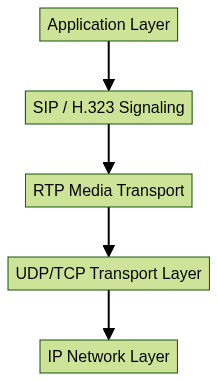VoIP and SIP Protocol: A Comprehensive Guide
Introduction to VoIP and SIP Protocol
Voice over IP (VoIP) has revolutionized real-time communication by enabling voice, video, and messaging over IP networks. At the heart of every VoIP solution are the protocols that coordinate signaling, media transport, and call management. The VoIP and SIP protocol stack is essential for network engineers and software developers building reliable, scalable communication systems. In 2025, understanding the nuances of VoIP and SIP protocol is critical for deploying secure and efficient enterprise communication solutions, troubleshooting issues, and optimizing quality of service (QoS).
Understanding VoIP Protocols
VoIP protocols define how voice and multimedia data are signaled, managed, and transmitted across IP networks. The primary VoIP protocols in use today include Session Initiation Protocol (SIP), Real-time Transport Protocol (RTP), and H.323. SIP protocol is the de facto signaling standard for call setup, modification, and teardown, while RTP handles the actual media transport. H.323, though older, still appears in legacy systems. Each protocol plays a distinct role in the VoIP and SIP protocol stack, working together to enable seamless real-time communication. For developers looking to integrate calling features, exploring a
phone call api
can provide a solid foundation for building robust VoIP applications.
Session Initiation Protocol (SIP) Explained
What is SIP?
Session Initiation Protocol (SIP) is a signaling protocol designed to establish, manage, and terminate multimedia sessions over IP networks. As the backbone of modern VoIP and SIP protocol architectures, SIP enables voice, video, instant messaging, and presence services. Its text-based, extensible design makes SIP protocol developer-friendly and adaptable to a wide range of real-time applications, from simple softphones to complex, distributed PBX systems. If you're building VoIP apps for iOS, following a
callkit tutorial
can help you implement seamless call handling and native call UI integration.SIP Architecture and Components
A typical SIP architecture consists of several key components:
- User Agents (UAs): Endpoints or devices (e.g., IP phones, softphones) that initiate and receive SIP requests/responses.
- SIP Proxy Servers: Route SIP messages between UAs, handle authentication and call routing.
- Registrar Servers: Manage SIP registration and user location.
- Redirect Servers: Direct SIP requests to alternate destinations.
Together, these elements form a robust SIP protocol infrastructure, supporting SIP trunking, NAT traversal, and secure communication across enterprise networks. For those interested in cross-platform development, exploring
flutter webrtc
can be valuable for building real-time communication features in Flutter apps.SIP Call Flow Process
The typical VoIP and SIP protocol call flow includes registration, call setup, media negotiation, and teardown. SIP messages like INVITE, ACK, BYE, and REGISTER coordinate these steps between endpoints and proxies. Developers can also leverage a
Voice SDK
to simplify the integration of audio features and manage call flows more efficiently.
SIP Packet Structure and Example
SIP messages are plain-text and human-readable. Here's an example of a SIP INVITE message:
1INVITE sip:alice@example.com SIP/2.0
2Via: SIP/2.0/UDP 192.0.2.1:5060;branch=z9hG4bK74bf9
3Max-Forwards: 70
4From: "Bob" <sip:bob@example.com>;tag=456248
5To: <sip:alice@example.com>
6Call-ID: 843817637684230@998sdasdh09
7CSeq: 1826 INVITE
8Contact: <sip:bob@192.0.2.1>
9Content-Type: application/sdp
10Content-Length: 142
11
12v=0
13o=bob 2808844564 2808844564 IN IP4 192.0.2.1
14s=-
15c=IN IP4 192.0.2.1
16t=0 0
17m=audio 49172 RTP/AVP 0
18RTP and Media Transport in VoIP
Role of RTP in VoIP
Real-time Transport Protocol (RTP) is responsible for the end-to-end delivery of audio and video streams in VoIP and SIP protocol environments. RTP provides timestamping, sequence numbers, and payload identification, ensuring smooth playback and enabling out-of-order packet handling. It operates on top of UDP for low-latency transmission, facilitating real-time interactions essential for business communication. For those developing Android applications, understanding
webrtc android
is crucial for implementing high-quality media streaming.How SIP and RTP Work Together
SIP protocol handles signaling—establishing, modifying, and tearing down calls—while RTP transmits the actual voice or video data. During SIP call negotiation, endpoints exchange Session Description Protocol (SDP) payloads specifying codecs, ports, and other media parameters. Once a call is accepted, RTP streams begin flowing directly between endpoints, independent of the SIP signaling path. If you want to quickly
embed video calling sdk
into your application, there are prebuilt solutions that streamline the process.RTP Packet Structure Overview
An RTP packet contains a header and a payload. Here's a simplified RTP header structure in hexadecimal format:
180 e0 00 01 00 00 00 01 00 00 00 01
280: Version, Padding, Extension, CCe0: Marker, Payload Type00 01: Sequence Number00 00 00 01: Timestamp00 00 00 01: SSRC Identifier
SIP vs. H.323: Protocol Comparison
While both SIP and H.323 are used for VoIP signaling, they differ in architecture, flexibility, and use cases. SIP protocol is more popular for modern deployments due to its simplicity, text-based messages, and ease of integration with web technologies. H.323, a binary protocol, is found in legacy video conferencing systems and carriers. For projects requiring robust video communication, integrating a
Video Calling API
can help deliver high-quality video experiences across platforms.| Feature | SIP Protocol | H.323 |
|---|---|---|
| Architecture | Decentralized, flexible | Monolithic, centralized |
| Message Format | Text-based (ASCII) | Binary |
| NAT Traversal | Better (with ICE/STUN/TURN) | Limited |
| Extensibility | High (custom headers/extensions) | Limited |
| Popularity (2025) | Very High | Niche/Legacy |
| Integration | Excellent (web, REST, APIs) | Poor (web integration) |
Implementing VoIP and SIP Protocol in Business
SIP Trunking and Deployment
SIP trunking replaces traditional phone lines with virtual trunks over IP, enabling scalable voice and unified communications. Deploying VoIP and SIP protocol solutions in business involves:
- Selecting SIP trunk providers
- Configuring SIP endpoints and PBX systems
- Ensuring SIP port and NAT traversal compatibility
- Setting up redundancy and failover
For those building iOS call features, a
callkit tutorial
can be invaluable in ensuring a smooth user experience and native call integration.Common Devices and Network Elements
VoIP and SIP protocol implementations require several devices and network elements:
- SIP Endpoints: IP phones, softphones, video endpoints
- SIP Proxies and Registrars: Manage signaling, authentication, and routing
- VoIP Gateways: Connect legacy telephony systems
- Firewalls/SBCs: Secure and control SIP/RTP traffic
Best Practices for VoIP Implementation
- Prioritize QoS for voice traffic
- Harden SIP endpoints and firewalls
- Regularly update and patch SIP devices
- Monitor call quality and logs
Security Aspects of VoIP and SIP Protocol
VoIP Security Threats
VoIP and SIP protocol environments face threats such as eavesdropping, toll fraud, spoofing, denial-of-service (DoS) attacks, and SIP registration hijacking. These risks can disrupt service and compromise sensitive data.
SIP Security Mechanisms
To secure VoIP and SIP protocol communications:
- Employ SIP over TLS to encrypt signaling
- Use SIP authentication (Digest, OAuth)
- Enable SRTP for media stream encryption
- Deploy SBCs and firewalls configured for SIP
- Disable SIP ALG on routers when possible
- Regularly audit SIP call logs and endpoints
SRTP and Secure Communication
Secure RTP (SRTP) encrypts audio/video streams, providing confidentiality and integrity for media in VoIP and SIP protocol deployments.
Troubleshooting and Optimizing VoIP and SIP Protocol
Common Issues and Solutions
VoIP and SIP protocol deployments often encounter:
- One-way/no audio (NAT or firewall misconfiguration)
- Registration failures (credentials, DNS, SIP port issues)
- Jitter, latency, or dropped calls (QoS or network congestion)
Solutions include verifying SIP port forwarding, disabling SIP ALG, updating endpoint firmware, and configuring QoS. For developers interested in advanced call handling, a
callkit tutorial
can provide step-by-step guidance for troubleshooting and optimizing iOS call experiences.Tools and Resources
Key resources for troubleshooting VoIP and SIP protocol include:
- Wireshark: Packet analysis for SIP/RTP
- SIPp: SIP traffic generator for testing
- Asterisk CLI/logs: Debugging SIP call flows
- Online tools: SIP header decoders, RTP stream analyzers
Conclusion: The Future of VoIP and SIP Protocol
In 2025, VoIP and SIP protocol remain foundational to modern business communications. As enterprises embrace unified communications, AI-driven call analytics, and edge computing, these protocols will continue evolving for scalability, security, and interoperability. Developers and network engineers mastering VoIP and SIP protocol are poised to lead the next wave of real-time communication innovation. If you're ready to start building with these technologies,
Try it for free
and accelerate your journey in real-time communications.Want to level-up your learning? Subscribe now
Subscribe to our newsletter for more tech based insights
FAQ